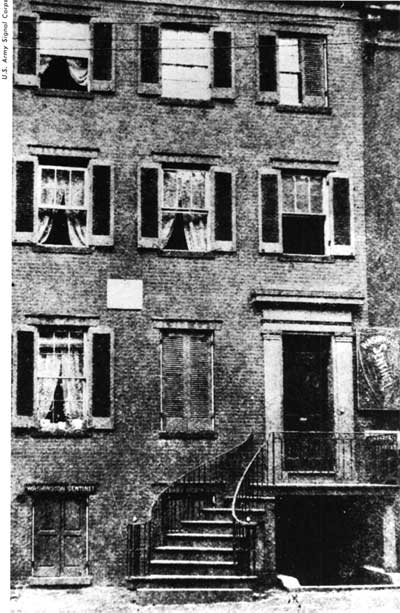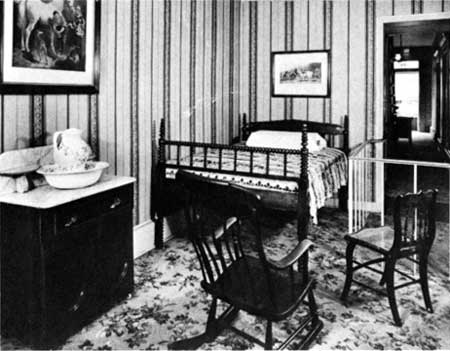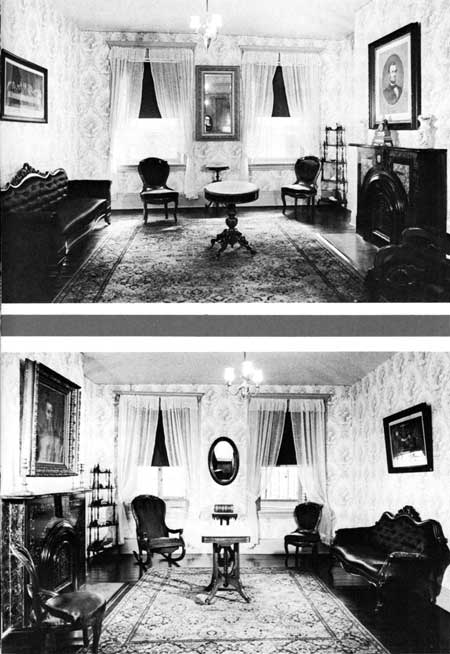|
FORD'S THEATRE National Historic Site |
 |

The Petersen house, a few years after Lincoln's death.
THE HOUSE WHERE LINCOLN DIED
The house in which Lincoln died, at 453 (now 516) 10th Street, NW., was built by William Petersen, a tailor of Swedish descent, in 1849. It is a three-story building, with the basement only slightly below the street level. Since the house had more rooms than the family required, he rented his extra rooms to lodgers. The bedroom to which Lincoln was taken was occupied by William T. Clark, a clerk at the Quartermaster General's Office and formerly a soldier of Co. D, 13th Mass. Infantry.
The walls of the bedroom at the time were covered with a brownish paper, figured with a white design. Some engravings and a photograph hung upon the walls. The engravings were copies of J. H. Herring's "Village Blacksmith," "The Stable," and "Barn yard." The photograph was one taken from an engraved copy of Rosa Bonheur's "Horse Fair." The furniture consisted of a bureau covered with crochet, a table, several chairs, and a low walnut bedstead. A worn Brussels carpet covered the floor.
The Petersen House remained in the hands of the Petersen family until November 25, 1878, when the heirs of William and Anna Petersen sold the property to Mr. and Mrs. Louis Schade for $4,500. Schade purchased the Petersen House for a home and for an office for his newspaper. The Washington Sentinel, of which he was editor, was published in the front room of the basement for many years. The room in which Lincoln died was used as a playroom by the Schade children. Schade added a room adjoining the back stairway, and one in the basement.
Although the building was unmarked on the outside, the Schade family was constantly besieged by tourists for permission to view the death room. From 1880, efforts were made in Congress to memorialize the home. In 1883, a marble tablet was placed on the outside of the house, telling of its tragic history. This marker was replaced in 1924 with a bronze plaque. The U.S. Government purchased the building in 1896 from the Schade family.
The House Where Lincoln Died, both on the exterior and the interior, has remained substantially unchanged in appearance since the time of Lincoln's death. Entering the building, you walk up the steps used in carrying the dying President into the house, and proceed through the hallway to the front and back parlors and to the room in which Lincoln died. The house was refurnished in 1932, after the Lincoln collection was moved to the Ford's Theatre building, by five women's patriotic organizations following as nearly as possible a diagram made shortly after the death of Lincoln. Labels in each room tell the history of the building and the events which took place there on the night of April 14 and the morning of April 15, 1865. The appearance of the building was greatly improved in 1959 by the extensive repairs and rehabilitation made under the Mission 66 program.

Top: The front parlor. Bottom: The back parlor.
The Front Parlor
The horsehair sofa and the high-back rocking chair in this room were once in the Lincoln home in Springfield. The sofa is in the same location as the one occupied by Mrs. Lincoln on the night of April 14 and the morning of April 15, 1865. The corner whatnots and center table are similar in appearance and in the same position as those in the room on the night of the assassination. On the mantel are two candlesticks which were presented by Lincoln to Caleb Smith, his Secretary of the Interior. The mantels and fireplaces in both the front and rear parlors are the originals.
The Back Parlor
The sofa in this room is also from the home of Lincoln in Springfield. A bed was placed in this location at the time of the assassination. The center table is similar to the one used by Cpl. James Tanner in taking shorthand notes from witnesses of the tragedy as interviewed by Secretary of War Stanton. Two vases, gifts of Lincoln to Caleb Smith, are on the mantelpiece.
The Room in Which Lincoln Died
The furnishings in the room are similar in appearance to those there at the time of the tragedy. An exact copy of the "Village Blacksmith" replaces the one that then hung on the wall, and above the bed is a copy of Rosa Bonheur's "Horse Fair." The wallpaper is a reproduction of the original pattern. The bed and chairs closely resemble those originally in the room at the time of Lincoln's death.


|

| History | Links to the Past | National Park Service | Search | Contact |
|
Last Modified: Mon, Dec 2 2002 10:00:00 am PDT |

